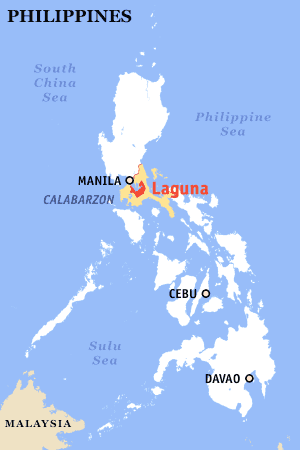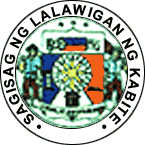Laguna
|
|
For other uses, see Laguna (disambiguation).
Laguna is a province of the Philippines found in the CALABARZON region in Luzon. Its capital is Santa Cruz and the province is located southeast of Metro Manila, south of the province of Rizal, west of Quezon, north of Batangas and east of Cavite. Laguna almost completely surrounds Laguna de Bay, the largest lake in the country. The province got its name from the Spanish word lago, which means lake.
2000 census—1,965,872 (6th largest)
Density—1,117 per km² (3rd highest)
Highly urbanized cities—0
Component cities—3
Municipalities—27
Barangays—674
Congressional districts—4

Laguna is notable for being the birthplace of José Rizal, the country's national hero. Laguna is also famous among tourists for the Pagsanjan Falls, the wood carvings created by the people of Paete and Pakil, the hot spring resorts in Los Baños on the slopes of Mt. Makiling, and Hidden Valley Springs in Calauan.
| Contents |
People and culture
Economy
- Natural Resources: Laguna is endowed with abundant natural resources. Its forests are filled with bamboo, rattan, and soft hardwood. Its wide fields and vast forests are ideal for growing rice, coconuts, vegetables, tropical fruits, orchids, and other ornamental flowers and exotic plants. The province is also rich in mineral resources such as clay, jasper and basalt glass.
There are about forty rivers in Laguna with a total area of almost 0.5 square kilometres. In the forests of Mount Makiling and in the waters of Laguna de Bay are an abundance of flora and fauna. The Laguna de Bay has an approximate area of 3800 km² broken down into 2900 km² of land and 900 km² of lake proper with 220 km shoreline.
Laguna's greatest natural resource is water. It has an estimated 300 million US gallons (1,100,000 m³) of underground water, capable of generating energy for Laguna's expanding power needs. At least seven principal water basins in the province with a total of 5,773 km² drainage area and 1,316 km² level area provide an estimated 9.238 km³ total run-off annually.
- Agricultural Activities: Crop Production, Livestock and Poultry Production, Fishing
- Investment Opportunities: Ecotourism enterprises; Convention centers; Coconut inter-cropping; Forest Trees, Cutflowers & ornamentals; Fruit & vegetable processing; Herbal medicines;Herbal essences; Gifts and housewares; Metalcraft (Industrial equipment, Engines, Surgical instruments, Agricultural machinery, tools); Service Facilities (Packaging, Warehousing, Trucking services, dryers); Electronics (Consumer electronics, Telecommunications, Computers & peripherals, Semi-conductors); and Garments and footwear; Agriculture; Fishing; Forestry; Tourism.
- Financial Institutions: Banking institutions maintain an extensive branch network in Laguna. Commercial banks, savings and mortgage banks, private development banks, stock savings and loan associations, and rural banks operated a total of 267 branches in the province.
Non-bank financial institutions provide supplementary financial services to Laguna residents and businesses. A total of 394 offices have been set up by lending investors, pawnshops, financial companies, nonstock savings and loan associations, and investment houses with quasi-banking functions.
- Exports: US$7.0 Billion (1997) out of total Philippine exports of $25 Billion
US$1.5 billion (1996)
Geography
Political
Laguna is subdivided into 27 municipalities and 3 cities.
Cities
Municipalities
Physical
Laguna lies on the southern shores of Laguna de Bay, the largest lake in the country. On the southern border of the province are Mt. Makiling and Mt. Banahaw, both extinct volcanoes, but still sources of geothermal energy. Mt. Makiling is popular for the numerous hot spring resorts that are found on its slopes. Pagsanjan Falls, is a popular waterfall that tumbles down a deep gorge in the hills.
The eastern portion of Laguna straddles the southernmost portions of the Sierra Madre mountain range.
Climate
The province is relatively dry from November to April and wet during the rest of the year for a small portion near the southern boundary. The other parts, west of Santa Cruz municipality, experience a dry season from November to April and rainy season during the rest of the year. The eastern and southern most portions do not have distinct season, with rainfall more evenly distributed throughout the year.
Tourist attractions
- Historical:
- Rizal Shrine, Calamba City - The Rizal Shrine is located in Calamba City and features the home of José Rizal.
- HommaYamashita Shrine, Los Baños
- Japanese Garden, Caliraya, Cavinti
- Underground Cemetery, Nagcarlan
- The Battle of Mabitac Mural, Mabitac. Cultural: National Arts Center, UP Los Baños
- Natural:
- Pagsanjan Falls, Cavinti - The Pagsanjan Falls used to be called the Magdapio Falls but have become popularly known as the Pagsanjan Falls because the trip starts in Pagsanjan. The falls are actually located upstream in Cavinti, and not in Pagsanjan as many think. The boat ride goes through many rapids before reaching the falls.
- Mount Makiling, Los Baños
- Hidden Valley Springs
- Crocodile Lake, Los Baños
- Seven Lakes, San Pablo City
- Dalatiwan River, Botocan, Majayjay
- Buruwisan Falls, Siniloan
- Man-Made:
- Enchanted Kingdom, Santa Rosa
- Boy Scouts of the Philippines Camp, UP Los Baños
- Valesol Haven, U.P. Los Baños
- Lake Caliraya, Lumban & Cavinti
- Hot Spring Resorts, Los Baños & Calamba
- Barong Makers, Lumban
- Paetes Woodcarving, Paete
- Religious: St. Gregory Church (Majayjay Catholic Church)
- St. James The Apostle Church (Paete Church)
- San Pedro De Alcantara Church (Pakil Church)
- Our Lady Of Candelaria (Mabitac Church)
- Educational:
- University Of The Philippines LOS BAÑOS (UPLB)
- Philippine High School for the Arts, Los Baños
- Museum Of Natural History, Los Baños
- University of the Philippines Botanical Garden, U. P. Los Baños
- Makiling Rainforest Park / Mt. Makiling Forest Reserve, U.P. Los Baños
- Kamalig Gallery, Paete; Aera Museum (Escudero Private Museum), San Pablo City
- The Coca-Cola Pavilion, CCBPI Plant, Santa Rosa
- Riceworld Museum International Rice Research Institute (IRRI), Los Baños
- Museum of the Wildlife Collections Of Dr. Dioscoro Rabor, Los Baños
- Entomology Museum, Institute of Biological Sciences Bldg., U.P. Los Banos
History
The Province of Laguna was named after the Laguna de Bay, the body of water that forms its northern boundary. Laguna de Bay, in turn, was named after the town of Bay, the first provincial capital. Captain Juan de Salcedo with a band of one hundred Spanish-Mexican soldiers and many Bisayan allies conquered the province and its surrounding regions for Spain in 1571. Seven years later, two Franciscan friars started the work of Christianization.
n 1577, the Franciscan missionaries arrived in Manila, and, thereafter, in 1578 they started evangelizing Laguna, Rizal, Tayabas (now Quezon) and the Bicol Peninsula. Fathers Juan de Placencia and Diego de Orepesa were the earliest Franciscans sent to these places. From 1580, the towns of Bay, Caliraya, Majayjay, Nagcarlan, Liliw, Pila, Santa Cruz, Lumban, Pangil and Siniloan were founded. In 1678, Fray Hernando Cabrera founded San Pablo de los Montes (now San Pablo City) and built a wooden church and convent considered as the best and finest in the province.
In 1670, delimitation of borders were made between Lucban, Majayjay and Cavite. The populous town at that time was Bay, the capital of the province until 1688, when the seat of the provincial government was moved to Pagsanjan, and later, in 1858, to Santa Cruz. In 1754, the Province of Laguna and Tayabas were divided, with the Malinao River separating the towns of Majayjay and Lucban.
The province became a bloody battle ground for the Chinese during the two instances that they rose in revolt against Spain. In 1603's, the Chinese made their last stand in the mountains of San Pablo, and in 1639, they fortified themselves in the highlands of Cavinti and Lumban, surrendering in Pagsanjan a year later.
The loyalty of the people of Laguna to the crown was tested during the British invasion (1762-1764) when thousands of Filipinos rallied to its defense. When a detachment of British troops under Captain Thomas Backhouse entered the province in search of the silver cargo of the galleon Filipino, Francisco de San Juan of Pagsanjan led a band of volunteers that fought them in several engagements in and around the town which was then the provincial capital (1688-1858). Captain Backhouse plundered the town and burned its newly reconstructed church but San Juan succeeded in escaping with the precious hoard to Pampanga where the treasure greatly bolstered the defense effort of Simon Anda. For his heroism, San Juan was made a brigade commander and alcalde mayor of Tayabas (now Quezon) province.
If Filipino loyalty gradually degenerated into bitter hostility, it was the fault of the Spaniards themselves, including the clergy. They perpetrated such grave abuses that the resentment of the Filipinos was fanned into a rising flood of nationalism. In 1840 for instance, religious intolerance led the people of Majayjay, Nagcarlan, Bay, and Biñan to join the revolt of Hermano Pule (Apolinario de la Cruz) of Lucban, Tayabas.
Laguna was also exposed to the aspirations of its most famous son, Dr. Jose Rizal, who was born in Calamba. The persecution of Dr. Jose Rizal and his parents toward the end of the century further aggravated the situation, so that by 1896, thousands of patriotic inhabitants, especially of Bay, Los Baños, Nagcarlan, Magdalena, Santa Cruz, and Pagsanjan had joined the revolutionary Katipunan.
Laguna was one of the eight provinces to rise in revolt against the Spanish misrule led by Generals Paciano Rizal of Calamba, Severino Taino of Pagsanjan, Agueda Kahabagan (woman general) of Calauan, and Miguel Malvar of Batangas. The ill-equipped Filipino forces fought the well-armed enemy until on August 31, 1898, when the last Spanish garrison surrendered to the victorious patriots in Santa Cruz. The province was cleared of Spaniards.There had been only one respite, the Pact of Biac-na-Bato on December 14 to 15, 1897.
Laguna actively supported the first Philippine Republic proclaimed at Malolos on January 23, 1899. Her two delegates to the Malolos Congress, Don Higino Benitez and Don Graciano Cordero, were natives of Pagsanjan.
Upon the outbreak of the Filipino-American War (1899-1901), General Juan Cailles and General Paciano Rizal led the defense of Laguna until June 30, 1901, when surrender became inevitable. Cailles became the first Filipino Governor of Laguna under the American flag.
The Province of Laguna progressed rapidly in peace. Roads were built, schools were established, and in 1917, the Manila Railroad Company extended its line to Laguna as far as Pagsanjan.
During the Japanese occupation (1942-1945), Laguna was a center of resistance despite the presence of Makapili traitors.
Present-day Laguna shows a thriving economy. Peopled by 1,734,618 (1997 estimated population) industrious citizens and possessing a total area of 1760 km² of land, Laguna produces millions of pesos worth of coconuts, rice, sugar, citrus fruits, lanzones and other products. Tourists flock to its beauty spots, especially Pagsanjan Falls, Los Baños Hot Springs, Makiling National Park, Caliraya Lake and many others. Levels of development vary. The towns near Metro Manila have become industrialized whereas the inner towns continue to engage in agricultural production or pursue agri-based industries and cottage and small-scale industries.
Laguna was one of the first sites of the Philippine Revolution. Calamba City is the birthplace of José Rizal, the country's national hero.
External links
- Official Website of the Provincial Government of Laguna
- Cavinti, Laguna Philippines
| Regions and Provinces of Luzon | |
| Ilocos Region: | Ilocos Norte | Ilocos Sur | La Union | Pangasinan |
| Cagayan Valley: | Batanes | Cagayan | Isabela | Nueva Vizcaya | Quirino |
| Central Luzon: | Aurora | Bataan | Bulacan | Nueva Ecija | Pampanga | Tarlac | Zambales |
| CALABARZON: | Batangas | Cavite | Laguna | Quezon | Rizal |
| MIMAROPA: | Marinduque | Occidental Mindoro | Oriental Mindoro | Palawan | Romblon |
| Bicol Region: | Albay | Camarines Norte | Camarines Sur | Catanduanes | Masbate | Sorsogon |
| Cordillera Adm. Region: | Abra | Apayao | Benguet | Ifugao | Kalinga | Mountain Province |
| Metro Manila: | No provinces |

